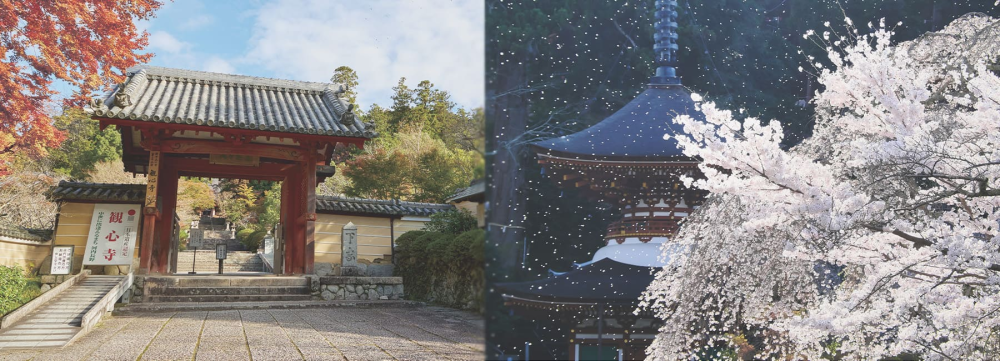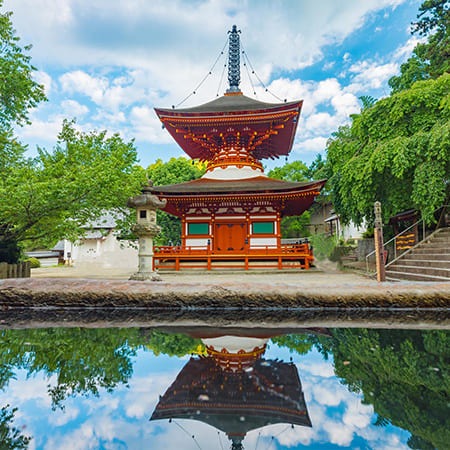
The Two Prominent Temples of Feudal Prosperity
Kawachinagano City is home to two distinguished temples, Kanshinji and Kongoji, which flourished in medieval Japan (12th to 16th centuries). Their prosperity was deeply tied to their strong connections with the Imperial Court. In the 14th century, a dispute over succession divided the Imperial Family into two factions: the Northern Court, based in Kyoto, and the Southern Court, based in Yoshino (present-day Nara Prefecture). Both courts engaged in separate political activities during this era, which is known as the Nanboku-cho (Northern and Southern Court) period. For a decade, Kanshinji and Kongoji temples served as temporary palaces for Emperor Go-Murakami of the Southern Court, briefly transforming Kawachinagano into a center of political power.

Kanshinji Temple
Kanshinji Temple was once a favored lodging for Kobo Daishi Kukai, the founder of Koyasan, during his journeys between Toji Temple (Kyoto), his base for spreading Buddhism, and Koyasan, his meditative sanctuary. Kobo Daishi Kukai entrusted his disciples with the renovation and expansion of Kanshinji Temple, establishing it as a vital center for the growth of the Shingon sect. The temple’s principal image, Nyoirin Kannon Bosatsu, is traditionally believed to have been carved by Kobo Daishi Kukai himself. This prominence led Emperor Saga (786–842) to designate Kanshinji as a prayer site, where prayers for national security and kigan (wishes) were offered. The temple flourished under the patronage of the Imperial Court.
Kanshinji Temple’s connections to the Imperial family extended beyond Emperor Saga, serving as a prayer site for Emperor Toba (1103–1156), further solidifying its ties to the throne. In 1359, Emperor Go-Murakami relocated from Kongoji Temple to Kanshinji Temple, conducting political affairs from there and adding to the temple’s historic legacy.
- Address
-
475 Teramoto, Kawachinagano City, Osaka 586-0053

Kongoji Temple
Kongoji Temple was established during the Nara period by the renowned monk Gyoki and is said to have served as a training ground for Kobo Daishi Kukai. Though the temple fell into decline for a time, it was later revitalized by Akan, a monk trained at Koyasan.
Kongoji Temple became a prayer site for Hachijo Nyoin (1137–1211). Hachijo Nyoin refers to Imperial Princess Akiko (also known as Shoshi), the daughter of Emperor Toba. The title “Hachijo” reflects the district where she resided, while “Nyoin” signifies her rank as a woman of status comparable to a retired emperor (In).
Due to its close ties with the Imperial family, Kongoji Temple played a pivotal role in the 14th century when Emperor Go-Murakami (1328–1368) used its jikido (dining hall) as a temporary center for political affairs and its sub-temple Mani-in as a provisional palace. Moreover, Emperor Go-Murakami confined his political adversaries from the Northern Court—Retired Emperors Kogon (1313–1364), Komyo (1322–1380), and Suko (1334–1398), as well as Prince Naohito (1336?–1398)—as hostages in Kanzo-in, a sub-temple of Kongoji Temple. For a time, Kongoji became a unique historical site where the rival factions of the Imperial family were forced to coexist within the temple’s walls.
- Address
-
996 Amanocho, Kawachinagano City, Osaka 586-0086
Copyright©Kawachinagano City. All Rights Reserved

